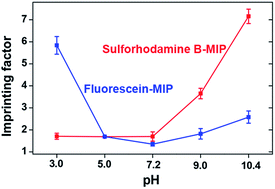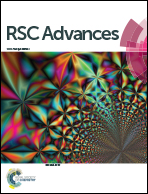Improving molecularly imprinted nanogels by pH modulation
Abstract
Molecularly imprinted polymers (MIPs) are polymerized in the presence of a template molecule. After removing the template, the polymer scaffold can selectively rebind the template. The imprinting factor (IF) refers to the rebinding ratio of imprinted and non-imprinted polymers. Generally, the IFs of most reported MIPs are quite low (e.g. below 3.0). This is partially attributable to strong non-specific interactions. In this study, imprinted nanogels are prepared using two common dyes as templates, sulforhodamine B (SRhB) and fluorescein. By varying the buffer pH, non-specific electronic interactions between the template and the gels are reduced, leading to improved IF for the SRhB-MIPs from 1.5 (at pH 7.2) to 7.4 (at pH 9.0). At the same time, the binding capacity of the MIP remained similar. On the other hand, while pH tuning also improved the IF of the fluorescein-imprinted nanogels, the binding capacity dropped significantly. Using isothermal titration calorimetry (ITC), the SRhB-imprinted nanogels display a much higher affinity (Ka = 2.9 × 104 M−1) than the non-imprinted (Ka = 0.031 × 104 M−1) when rebinding is conducted in high pH (pH 9.0). This difference is mainly driven by enthalpy. This study suggests that pH tuning can be used to further improve MIPs.


 Please wait while we load your content...
Please wait while we load your content...